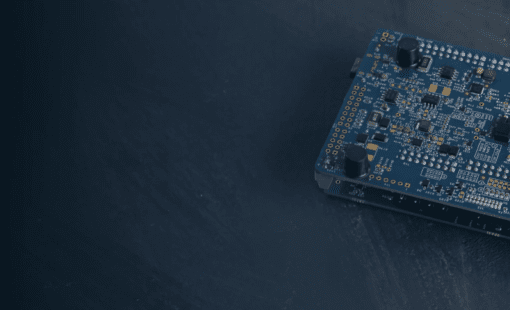Efficiency and adaptability have become crucial in modern electronics design. Utilizing circuit blocks enables designers to create sophisticated systems quickly. By leveraging reusable components, teams can reduce design time and costs and enhance the quality and scalability of their products. This post will explore the fundamental concepts of circuit blocks, their advantages, and best practices for building a practical library to optimize your design workflow.
What are Circuit Blocks and Why Use Them?
Modular electronics design involves creating electronic systems using pre-designed, reusable modules or circuit blocks. Each circuit block performs a specific function that designers can easily integrate into larger systems. This approach allows designers to focus on individual modules, simplifying the design and testing process. It promotes efficiency, reusability, and ease of troubleshooting.
The benefits of employing reusable circuit blocks are:
- Reduced design time and development costs by avoiding reinventing similar circuits multiple times. Furthermore, teams can split the work effort to focus on separate modules simultaneously, which speeds up the development process.
- Modular designs are inherently scalable. Adding new features or functionalities often requires only the creation and integration of new modules, with minimal impact to the overall system.
- Improved quality by utilizing proven circuits with known reliable parts.
- Improved competitiveness by delivering new products to the market quicker.
- Reusing parts from previous designs will reduce inventory management costs and provide advantageous volume pricing opportunities.
Building a Circuit Block Library
Creating a library of circuit blocks involves defining commonly used circuits into individual functional blocks. Each block should be independently designed and tested before being added to the library, reducing complexity and allowing for easier debugging.
If desired, Zuken’s CR-8000 electronics design environment allows users to manage collections of circuit blocks within a single schematic. Users can create a library of circuit blocks from one or several schematics. Blocks within a schematic can have their own review and approval flows and be released individually, as needed. DS-CR, Zuken’s electronic product data management system, will organize and manage documentation and related design artifacts, such as test models, inputs, and results within the circuit block library.

Types of circuit blocks
The Zuken design environment offers several circuit block types to support the design methods employed by various customers. Companies typically choose one or two circuit block types that best fit their modular design process and standardize their procedures for using them.
Here is a brief description of each type.
Link-type
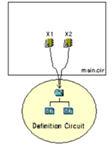
One or more blocks refer to a single definition circuit. If the definition circuit changes, all blocks that refer to it are affected. This approach is suited for semiconductor designs that use models with the same structure repeatedly.
Shared-type
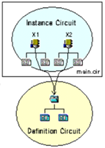
Users can only change the properties in the instance circuits. Users can reflect changes to the definition circuit in each instance circuit. This approach is suited for PCB designs that share approved functional blocks, as it prevents editing the contents of definition blocks.
Copied-type
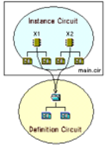
Users can change the instance circuit without any restrictions. Users can reflect changes to the definition circuit in each instance circuit. This approach is suited for PCB designs that share functional blocks.
Embedded-type
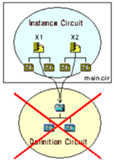
The relationship between the instance and definition circuits is cut off, enabling the unnecessary definition circuit to be deleted, thus reducing the amount of data. Designers can use this if they do not require shared or copied circuit data at the final stage of circuit design.
The embedded-type cannot be changed to the link-, copied- or shared-type.
Utilizing Circuit Blocks from the Library
After establishing a library of circuit blocks, you can easily use them in a new schematic or add new features to an existing schematic.
Zuken’s DS-CR has a drag-and-drop user interface that enables easy circuit block reuse. To use it, simply drag circuit block definitions from the library into your schematic.
When reused, circuit blocks retain their hierarchical structure in a schematic. The engineer can decide if a circuit block retains the original definition of its circuit or if they can modify the instance to suit the requirements of a new product. Either way, the DS-CR system tracks the history of all circuit blocks. Where-used reports show the definition and instance of each block, even if a block has been reused through several iterations in a product’s evolution. This is especially helpful for assessing the impact of design changes.
Shift Happens—How to Manage Changes
Electronic products constantly evolve due to shifts in consumer preferences to take advantage of technical advancements and efforts to reduce costs while improving quality and reliability.
As mentioned above, a capable product data management system for electronics tracks the history of circuit blocks, allowing engineers to trace their usage ancestry. An advanced system will also show the version numbers of the definition and reused copies. Ideally, it can compare the schematics of the source and instanced circuit blocks to highlight differences and update the copy to match the revised definition, if desired. Combining Zuken’s DS-CR data management system with CR-8000’s Design Gateway schematic application provides these powerful circuit block management capabilities.

Demonstration using Zuken’s DS-CR and Design Gateway applications
Check out our technical videos on the Zuken Americas Community for demonstrations on creating circuit block libraries and more. The Community has tons of great content for both DS-CR and CR-8000.
Conclusion
Modular electronics design using circuit blocks offers a structured and efficient approach to building complex electronic systems. By focusing on individual modules, designers can streamline the development process, reduce errors, and enhance system flexibility. Efficient reuse of these modules further boosts productivity and product quality, making it a valuable strategy in modern electronics design.
Zuken’s design product suite simplifies creating and utilizing a circuit block library and includes robust features for assessing and implementing design changes as needed.
Related Products and Resources
- Products

- Products
Building a competitive product today is much more difficult than a few years ago. Existing PCB-centric design processes are limited to a single PCB and do not provide the necessary tools for today’s competitive product development environment. PCB-centric design processes are falling behind.

- Brochure



